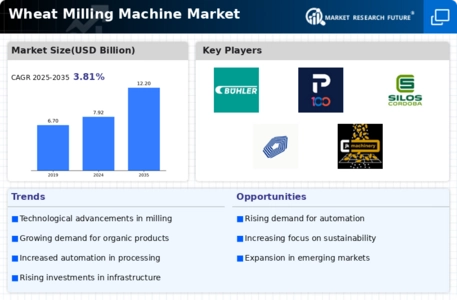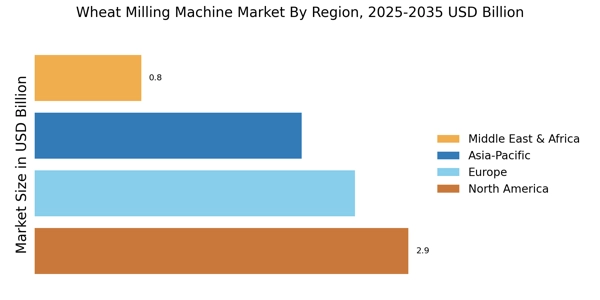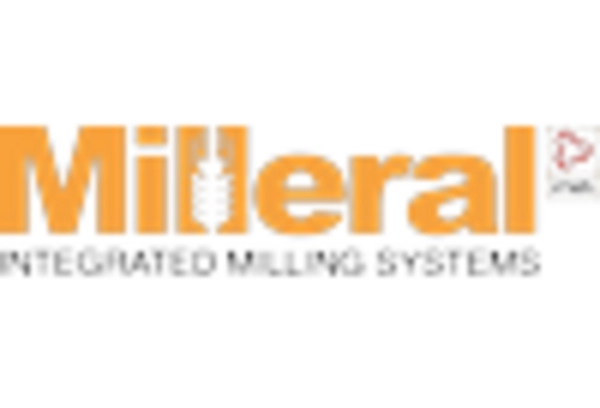Increasing Demand for Flour Products
The rising demand for flour-based products, such as bread, pasta, and baked goods, is a primary driver of the Wheat Milling Machine Market. As consumer preferences shift towards convenience foods, the need for efficient milling processes becomes paramount. In recent years, the flour market has shown a steady growth rate, with projections indicating a compound annual growth rate of approximately 4.5% over the next five years. This trend necessitates the adoption of advanced milling technologies to meet the increasing production demands. Consequently, manufacturers are investing in modern milling machines that enhance efficiency and reduce operational costs. The Wheat Milling Machine Market is thus poised to benefit from this growing demand, as producers seek to optimize their milling operations to cater to the evolving consumer landscape.
Expansion of the Food Processing Sector
The expansion of the food processing sector is a crucial driver for the Wheat Milling Machine Market. As countries continue to industrialize, the demand for processed food products is on the rise. This growth is particularly evident in regions where urbanization is accelerating, leading to increased consumption of flour-based products. The food processing industry is projected to grow at a rate of approximately 6% annually, which directly impacts the milling sector. Millers are thus compelled to enhance their production capabilities to meet the rising demand for flour. This scenario creates opportunities for manufacturers of milling machines to innovate and provide solutions that align with the evolving needs of food processors. The Wheat Milling Machine Market stands to gain significantly from this trend, as investments in milling technology become essential for meeting production targets.
Rising Health Consciousness Among Consumers
The increasing health consciousness among consumers is driving changes in the Wheat Milling Machine Market. As more individuals seek healthier food options, there is a growing preference for whole grain and organic flour products. This shift is prompting millers to adapt their processes to produce higher-quality flour that meets these health standards. The market for whole grain flour has been expanding, with a notable increase in sales reported in recent years. This trend necessitates the use of specialized milling machines capable of processing whole grains while preserving their nutritional value. Consequently, the Wheat Milling Machine Market is likely to see a rise in demand for equipment that can cater to these health-oriented products, thereby influencing production strategies across the sector.
Technological Innovations in Milling Equipment
Technological advancements in milling equipment are significantly influencing the Wheat Milling Machine Market. Innovations such as automation, digitalization, and the integration of artificial intelligence are transforming traditional milling processes. These technologies enable millers to achieve higher precision, improved yield, and reduced energy consumption. For instance, the introduction of smart milling systems allows for real-time monitoring and adjustments, enhancing overall operational efficiency. As a result, the market for advanced tree milling machines is expected to expand, with estimates suggesting a growth rate of around 5% annually. This trend indicates a shift towards more sophisticated milling solutions, which are essential for meeting the demands of modern flour production. The Wheat Milling Machine Market is thus likely to experience a surge in demand for technologically advanced equipment.
Government Support and Investment in Agriculture
Government support and investment in the agricultural sector are pivotal factors influencing the Wheat Milling Machine Market. Many governments are recognizing the importance of food security and are implementing policies to bolster agricultural productivity. This includes financial incentives for farmers and investments in modern milling technologies. Such initiatives are aimed at enhancing the efficiency of grain processing and ensuring a stable supply of flour to meet domestic and international demands. Recent reports indicate that government funding for agricultural innovation has increased, which is likely to stimulate growth in the milling sector. As a result, the Wheat Milling Machine Market is expected to benefit from these supportive measures, as they encourage the adoption of advanced milling solutions that improve overall productivity and sustainability.


















Leave a Comment